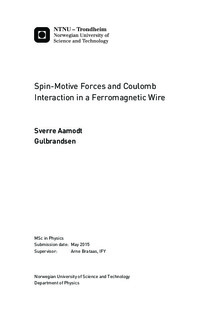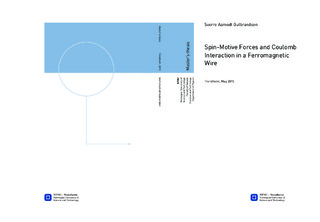| dc.description.abstract | In metallic ferromagnets, external voltages induce charge and spin-polarized currents. Additionally, there can be magnetization dynamics, where the magnetic moments precess in time in response to external magnetic fields. The exchange interaction strongly couples the spin-polarized currents with the magnetization dynamics. In this way, external voltages can induce magnetization dynamics or, vice versa, external magnetic fields can induce currents.
In ferromagnets, the long-range dipole interaction leads to the formation of magnetic domains, regions of aligned magnetic moments. In between the magnetic domains, there are domain walls, where the magnetization gradually varies. Such domain walls move in response to external magnetic fields. Previous studies have shown that a moving domain wall in ferromagnets generates a spin-motive force on the conduction electrons. In turn, the spin-motive force generates currents. Experimentally, the spin-motive induced currents have been detected.
So far, research in this field has neglected the ubiquitous Coulomb interaction between the electrons. The central question we address is how Coulomb interaction between electrons affects the transport of the electrons subject to the spin-motive forces.
To study this question, we first reproduce the known results of spin-motive forces when the magnetic domain wall is of the Neel type. The moving domain wall generates a spin-polarized electric current. We discuss its Berry s phase origin. Beyond previous studies, we find that the Coulomb interaction between the electrons leads to the screening of the spin-motive induced accumulated charges. The screening takes within the Thomas-Fermi screening length, which is very short in high-density metals. While screening strongly modifies the accumulated charges in the ferromagnets, the domain wall motion induced currents remains unaffected due to current conservation. | |

